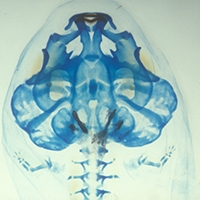Citation:
| 1.99 MB |
Date Published:
Sep 1Abstract:
Based primarily on studies in the chick, it has been assumed that the zinc finger transcription factor Slug is required for neural crest migration. In the mouse, however, Slug is not expressed in the premigratory neural crest, which forms normally in Slug -/- animals. To study the role of Slug in Xenopus laevis, we used the injection of XSlug antisense RNA and tissue transplantation. Injection of Slug antisense RNA did not suppress the early expression of the related gene XSnail, but led to reduced expression of both XSlug and XSnail in later stage embryos, whereas the expression of another neural crest marker, XTwist, was not affected. Down-regulation of XSlug and XSnail was associated with the inhibition of neural crest cell migration and the reduction or loss of many neural crest derivatives. In particular, the formation of rostral cartilages was often highly aberrant, whereas the posterior cartilages were less frequently affected. The effects of Slug antisense RNA on neural crest migration and cartilage formation were rescued by the injection of either XSlug or XSnail mRNA. These studies indicate that XSlug is required for neural crest migration, that XSlug and XSnail may be functionally redundant, and that both genes are required to maintain each other's expression in the neural crest development of xenopus laevis. (C) 1999 Academic Press.
Notes:
233HRTimes Cited:100Cited References Count:71






